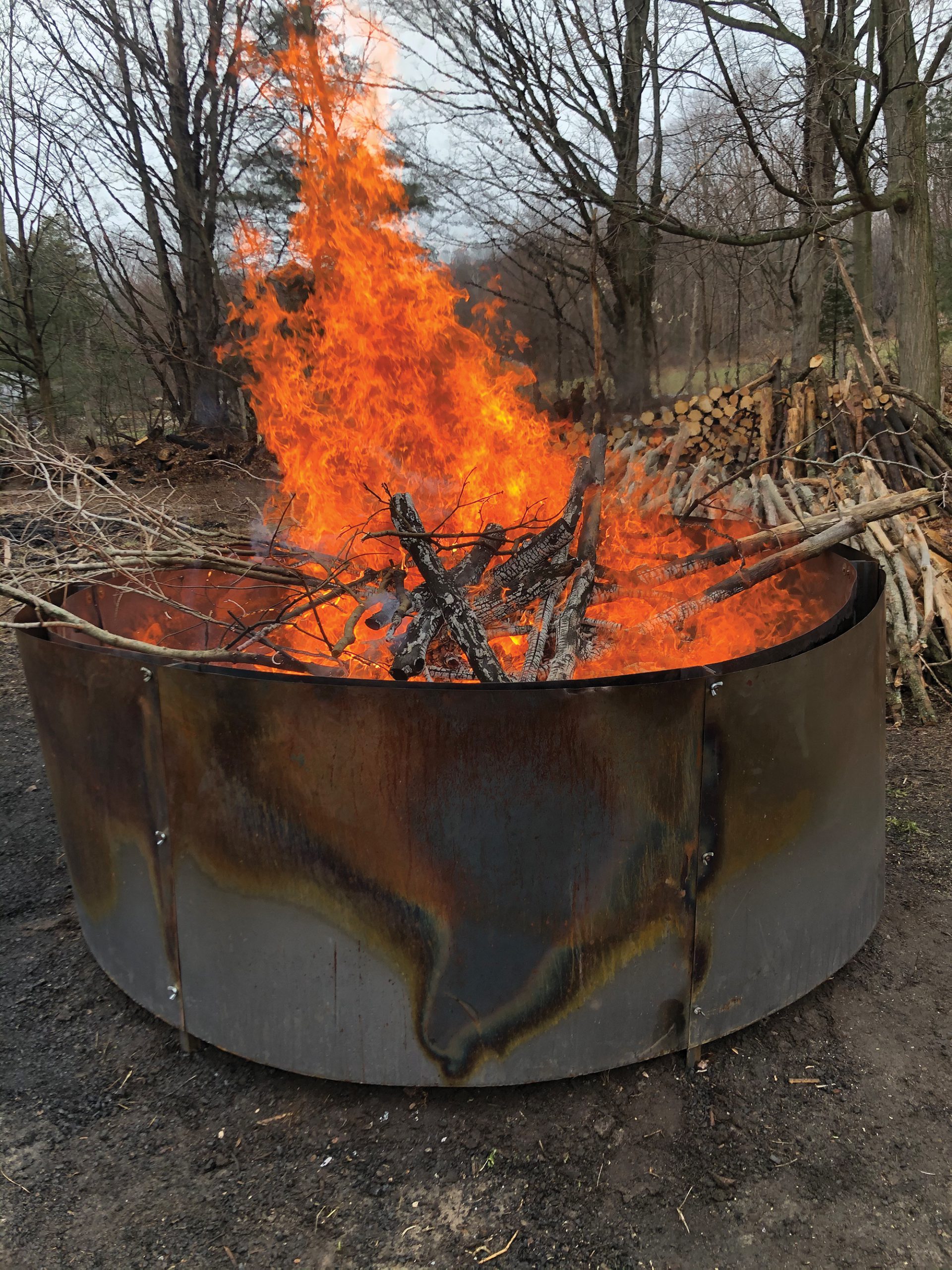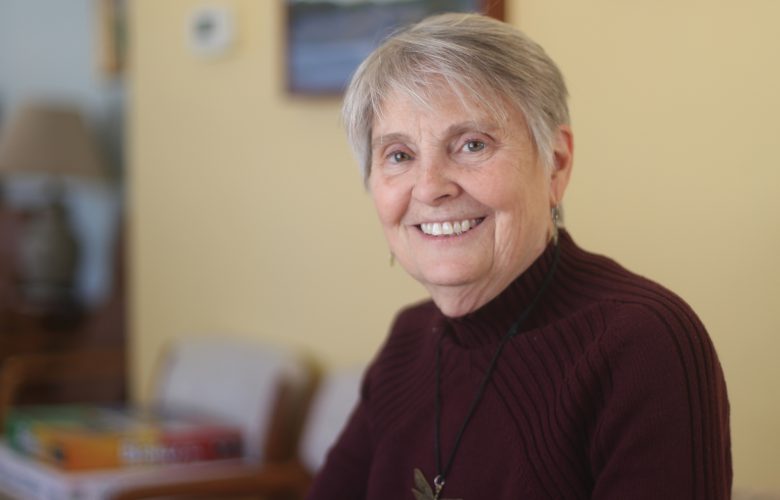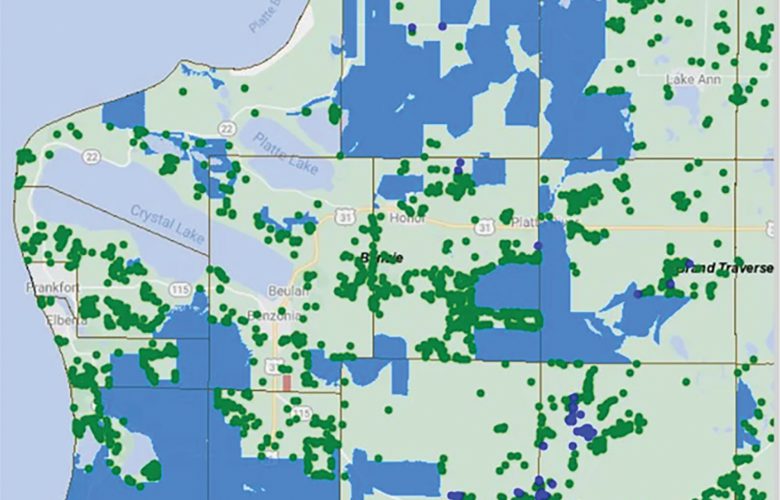Everything old is new again
By Maggie Roberts VanHaften
Current Contributor
It is a sunny afternoon in late April on Lobb Road at The May Farm, where attention is focused on a fire that is burning within a large metal kiln. Paul May (65), with assistance from his brother Steve (69), is tossing branches, limbs, and twigs into the fire. The double-walled kiln—which is approximately four feet high and 10 feet across—is burning very hot; there are no raging flames shooting in the air, and there is little smoke.
May is not preparing for a giant weenie roast; he is making biochar, which he will use to fortify the soil in his fields.
Biochar is the product of organic matter—for example, wood, corn husks, and garden debris—burned at a high temperature with little-to-no flow of oxygen. It is a process known as “pyrolysis,” which reduces the organic matter to carbon, the basic chemical of all life.
Before the charred wood, or “char,” is reduced to ash, May will pull over the nearby hose, put out the fire, and chop the remains into chunks that fit in the palm of his hand. What is left is called “biochar,” porous carbon with a structure much like a honeycomb or coral. He will mix, or “inoculate,” the biochar with manure and/or compost—which will fill the pores of the char—cover it with water, and later spread it on his fields. This inoculated biochar is a natural fertilizer that will enhance the soil for years to come.
This may not be the first time that you have heard about biochar—as Jonathon Swift said, “Everything old is new again.”
Biochar is nothing new. Early use of biochar can be traced to the Brazilian rainforest more than 2,000 years ago. Scientists wondered why certain areas of the rainforest were highly fertile, while other areas were not. Analysis showed that the fertile soil contained charred wood, terra cotta pottery shards, and animal and plant waste. This soil is called “terra preta,” or “dark earth.”
By spreading inoculated biochar on his fields, May is relying on this ancient technology to create fertile, dark earth.
Carbon is necessary for healthy plant life. Without sufficient carbon in the soil, plants will fail to thrive. Loss of carbon occurs when the soil is overused—often by traditional farming methods—and there is so much rain that the sandy soil cannot hold, resulting in run-off and erosion, or conversely, too little moisture, allowing the top soil to blow away in the wind. The once-fertile soil will become, in essence, dirt that is unable to support healthy plant growth.
For example, during the 1930s in the United States, the grain-producing Plains states experienced what is now known as The Dust Bowl. While there were many contributing factors, one major cause was the loss of quality soil through ineffective land management—the soil did not retain moisture or nutrients. When coupled with a drought and high temperatures, the once-fertile soil turned to dust and blew away.
Biochar proponents, such as May, believe that proper soil management—including use of biochar—will prevent such problems from occurring in the future, especially as we see our climate change. In essence, as May says:
“We can turn dirt into soil by enhancing the ground with carbon.”
Biochar—with its honeycomb or coral-like structure—soaks up nitrates, phosphates, and other necessary nutrients through the inoculation process. When added to the soil, it protects the beneficial elements from run-off, replenishes carbon, and retains soil moisture and nutrients. These changes eliminate the need for constant watering and synthetic fertilizers, resulting in flourishing plants. In addition, biochar can benefit the soil for years to come, as witnessed by the studies in the rainforest.
When asked why he goes to the trouble of making biochar, May responds:
“It’s something I can do to help solve the problem of the degradation of the soil and atmosphere.” He waves his arm at the fields surrounding him. “I mean, the carbon that I put back into the ground and keep out of the air will benefit this land long, long after I’m gone. My kiln is designed to use little or no oxygen in the burning process; I am keeping the carbon from mixing with oxygen and rising into the atmosphere as carbon dioxide. We know we have ground, water, and atmospheric problems world-wide. In this case, our soil has been over-farmed and lost its fertility.”
May goes on:
“A 2006 study at Cornell University found that Earth’s soil was being degraded faster than it’s being replenished. At a time when food demands are increasing, I find this scary. We try to improve soil by adding synthetic fertilizers but don’t look ahead enough to view the side-effects: the run-off into lakes and streams and resulting damage to life. There are plenty of examples, but for a major impact, we just need to look at years of problems in the Lake Erie basin. Agricultural run-off—including the synthetic fertilizers—flowed into Lake Erie, causing an extensive algae bloom that killed water life. The drinking water became toxic, and bottled water had to be brought in. This is not a unique situation; it’s happening around the country; around the world. While some wait for global remedies, I prefer to take action, to take control of what I can now.”
He pauses: “In simple terms, I’m doing a demonstration project. Others may choose another action, but I sure hope we all do something.”
Asked if there are any downsides, May points out that you need good-quality wood to start the process.
“Charcoal—like you put in your grill—has additives that can be detrimental,” he says. “If you use wood that has been treated or painted, or that contains heavy metals, those chemicals will be retained and they will end up in the ground with your biochar, which is also detrimental to what you are trying to accomplish.”
May has worked with several people in the area to incorporate biochar into their gardens. For instance, Deb Northway had May help her use inoculated biochar on her property in Benzonia.
“I was interested in trying to supplement the sandy soil of an old Christmas tree farm,” she says. “We tried compost and composted leaves but still needed something more. We also used this soil and biochar mix when planting saplings from the [Benzie] Conservation District.”
Biochar—especially inoculated biochar—has potential on all levels. Sure, backyard gardeners can mix biochar with the soil in their tomato beds, but there are also applications for large-scale agricultural operations.
New Zealand and Australia are examining the benefits of inoculated biochar on orchards. Some farmers in the Midwestern United States are experimenting with inoculated biochar on their grain fields. A group of vineyard owners in California are using it to combat dry, hot weather.
Faced with the need to feed more people, farmers around the world are turning to natural, environmentally friendly soil-enhancement techniques, including biochar.
Of course, not everyone who wants to use biochar can make sufficient amounts to meet their needs.
Benzie County Commissioner Karen Cummingham (D – City of Frankfort, Crystal Lake Township, parts of Lake Township) is participating with representatives of 14 other Michigan counties as part of a Michigan Association of Counties committee focusing on natural resources and environmental issues. Cunningham explains how she sees biochar benefiting Michigan counties, and the northwest corner of the Lower Peninsula, in particular:
“We want our agricultural environment and policies to work for farmers; we want to see them thrive, whether they are producing grains or grapes. And, we also want to prevent agricultural run-off into our lakes and rivers. Degraded soil will not help us to accomplish those goals. Without a change, the constant cycle of fertilization and irrigation will continue; it is not a sustainable situation. These are people’s livelihoods we are talking about, as well as our future food supply.”
Cunningham goes on to add another aspect of this discussion: biochar is currently not available in an amount to provide to farms.
“While Paul May and most of the rest of us who want to add biochar to our gardens can make it or buy small quantities at reliable garden stores, what about farmers? As I understand it, there are only a few large-scale producers in the state. If Michigan farmers want to use biochar, they often need to go out of state to get it, increasing the transportation cost. Imagine the possibility of a new industry in this part of the state: manufacturing biochar,” she says. “We have the wood, we have mulch and manure. Large-scale biochar facilities can harness the heat energy for other purposes.”
According to Cunningham, there are $60,000 non-competitive grants available to counties for environmental projects. If Benzie joins with at least two other counties, each county could get a grant, and there would be the potential of additional funds that could be used to expand the use of biochar in this region.
May has been demonstrating how to make biochar at his farm and in a class at Grow Benzie. He is willing to help people learn more in whatever way he can.
Additionally, Michigan State University’s Cooperative Extension service is part of the Great Lakes Biochar Network (GLBN), working to promote the benefits of biochar, research best practices, establish manufacturing partnerships, and promote consumer education.
It is possible to make your own biochar. A campfire’s char generally uses too much oxygen, resulting in the carbon joining with the oxygen and going up in smoke. There are many designs for biochar kilns, from small kilns made out of cans to large ones like May’s. Some makers have had luck with fires in trenches or pits.
Anyone making biochar must follow local fire-safety requirements. Biochar must be made outside and sited away from anything flammable, including structures, vehicles, plants, overhanging branches, and any chemicals. A biochar fire is hotter than a regular campfire and poses a burn risk, if precautions are not taken to prevent accidents, including fires spreading and burns to those nearby. Children should be kept a distance from the fire. A nearby hose with running water is necessary, not only for putting out the fire in the kiln before the wood becomes ash, but also if an ember falls onto the ground. As with any fire, burn restrictions must be followed; check with your local fire department before starting to burn.
Paul May periodically demonstrates the biochar process at his farm. He can be reached at 231-352-5210. Many resources are available for additional information:
• MSU Cooperative Extension – extension.msu.edu
• Great Lakes Biochar Network – canr.msu.edu/biochar/
• Pacific Northwest Biochar Atlas – pnwbiochar.org/about-atlas/
• USDA – •climatehubs.usda.gov/hubs/northwest/topic/biochar
• International Biochar Initiative – biochar-international.org/resources/research-tools/
Featured Photo Caption: The May Farm’s biochar kiln. Photo courtesy of Paul May.




